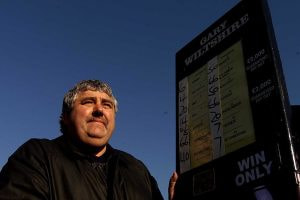Which Is the Best F1 Track?
Silverstone or Monaco: Which is the Best F1 Track?

In the exhilarating realm of Formula 1 racing, where speed meets precision and ever split-second decision can make or break a race, the tracks themselves play a pivotal role in the drama. Given the impact they can have on a driver and fan’s weekend, we’ve decided to tackle the question, which is the best F1 track?
To rank the circuits that define the pinnacle of motorsport, BestBettingSites.com looked at a range of factors, including:
- Venue capacity
- Average attendance per day
- Total number of turns
- Distance of race (km)
- Percentage of races won from outside of pole position
- Lap record (average speed in km/h)
- Max speed (km/h)
- Percentage of the race spent in full throttle
So, strap in as we rev our engines and determine the best Formula 1 circuit!
The Top 10 Best Formula 1 Tracks
23 tracks were used in the 2022 Formula 1 season, but only a select few can reach our top 10. Based on various metrics including capacity, average price, max speed and so much more, we’ve collated this list of the definitive best F1 circuits.

1. Autodromo Nazionale di Monza – 9.05

Taking the pole position on our list of the best Formula 1 tracks is the Autodromo Nazionale di Monza. Simply known as Monza, the circuit was built in 1922 and was the first purpose-built motor racing circuit opened in continental Europe.
This legendary circuit has seen its fair share of extraordinary races, none more so than the 1971 running of the Italian Grand Prix. After 55 laps of high-octane racing, the final five drivers were effectively inseparable going into the final bend. BRM’s Peter Gethin did just enough to get over the line first, finishing 0.010 seconds ahead of March’s Ronnie Peterson.
Monza doesn’t sit at the top of the podium just because of its illustrious history, Italy’s most famous circuit still delivers excitement in almost every Grand Prix. As max speeds hit 350 km/h, and, with 84% of the circuit raced in full throttle, there is no room for complacency when it comes to racing at the Temple of Speed.
2. Imola – 8.77

Another circuit in Italy, Imola has a chequered history. Initially used for motorcycle racing, Imola hosted a Grand Prix every year between 1980 to 2006. A scene of various tragedies, including the death of Ayrton Senna, Formula 1 eventually decided the circuit was too dangerous to race on.
However, after various alterations were made, Formula 1 action returned to Imola in 2020, for the Emilia Romagna Grand Prix. Since then the circuit has solidified itself as one of the best Formula 1 tracks once again. In the three races at the circuit since its return, Max Verstappen has been victorious in two, whilst Lewis Hamilton has won one. The excitement of these three races proved that Imola is still one of the best F1 circuits around.
Despite the revisions to the circuit, Imola remains one of the fastest tracks around. The lap record time of 1:15.484 is one of the quickest on the F1 calendar, and is also the only other F1 track where racers hit speeds of 350 kmh. Races at Imola are also relatively unpredictable, with over two-thirds (67%) of races ending with winners who didn’t start on pole.
3. Silverstone Circuit – 8.51

Just sneaking onto the podium is Silverstone. The Silverstone circuit, which hosted its first British Grand Prix in 1950, was once an RAF base, yet when hostilities were finished the base was converted into a race track.
Silverstone has seen countless unforgettable moments. In 1969, Jackie Stewart became the first British racer to win the Grand Prix at Silverstone, crossing the line without a working clutch. In 1991, another British racer, Nigel Mansell, captured the public’s imagination for not only winning the Grand Prix but also giving Aryton Senna a lift back to the pit lane after his car ran out of petrol.
And in more recent memory, Lewis Hamilton became the first driver in F1 history to win six British Grand Prix when he crossed the line first in 2019.
Although Silverstone isn’t quite as fast as it used to be, it still has a habit of attracting tremendous crowds. With a capacity of 160,000, it sold every single seat for practice, qualifying, and race day itself in 2022, making it one of the best F1 tracks for atmosphere. No other circuit in F1 can boast such impressive numbers.
4. Jeddah Street Circuit – 7.84

One of Formula 1’s newer circuits, the Jeddah Street Circuit in Saudi Arabia, is quickly becoming a fan favourite. In the short time the Jeddah Street Circuit has been a mainstay of the F1 schedule, no driver has been able to retain their title at the circuit.
Lewis Hamilton was the inaugural winner in 2021, but he could only muster a 10th-place finish when the race returned a year later. On that occasion, Max Verstappen took the spoils. In 2023, Verstappen’s Red Bull teammate, Sergio Perez, stood aloft on the podium as he finished a comfortable 5.355 seconds ahead of the Dutchman.
Despite being made up of 27 bends (more than any other F1 circuit), drivers at the Jeddah Street Circuit still have to drive at full throttle if they are to finish first. The max speed on the track is 330km/h, which makes it the third fastest F1 track for top speed outside of Europe. Jeddah is clearly one of the best F1 circuits added to the calendar in recent years.
5. Circuit de Spa-Francorchamps – 7.75

Spa-Francorchamps is one of the most iconic F1 tracks in the world. Situated in the heart of the Ardennes Forest, F1 fans from every corner of the globe dream of flocking to this elusive destination.
The Spa circuit was the scene of not only Michael Schumacher’s first race but also his first victory in 1992. Almost a decade later, Schumacher was stunned not to win again at Spa, after Finnish driver Mika Hakkinen pulled off one of the most audacious overtakes in the history of F1, to pip the then two-time world champion to the chequered flag.
Apart from the ferocious atmosphere, Spa is beloved by F1 fans for its spectacular corners, stunning scenery, and undulating geography. It has the longest flat-out of all the circuits currently on tour and also the longest lap length — twice the length of Monaco’s. When you consider these stats it is easy to see why many believe it’s one of the best Grand Prix tracks around.
The Rest of the Top 10
Elsewhere within the top 10, Suzuka sits in sixth. Not only is the circuit for the Japanese Grand Prix a great track for racing, it also has the second-lowest average price for spectators, charging £231 for the average ticket.
The Baku City Circuit, which first hosted the Azerbaijan Grand Prix in 2016, crosses the line in seventh. Now a staple of the F1 calendar, Baku’s circuit is one of the most unpredictable around, with just two of the seven drivers to start on pole position subsequently winning on race day.
Red Bull are used to winning championships, but the Red Bull Ring will have to settle for eighth on our list of best F1 tracks. The host circuit of the Austrian Grand Prix has the fastest lap record around, at 1:05.619. This record was set by Carlos Sainz Junior whilst racing for McLaren in 2020.
Melbourne’s Albert Park is ninth on our list. Once the customary season opener, Albert Park is celebrated by F1 fans for being a good all-round venue, enjoyed by spectators and drivers alike.
In tenth is the Nurburgring. Nicknamed ‘Green Hell’ by Jackie Stewart, the scene of the Eifel Grand Prix has just 15 turns and demands racers to drive at full throttle almost three-quarters (74%) of the time if they are to end up on top.
The Top Five Worst F1 Tracks

1. Circuit de Monaco – 5.3

F1 fans have mixed feelings about the Monaco Grand Prix. Whilst it boasts a rich history and unparalleled glamour, the tight street circuit often limits overtaking, leading to races becoming something of a procession.
The atmosphere at Monaco can also feel rather corporate, feeling more like a networking event for the super-rich than a sporting contest.
Monaco also has the highest ticket prices in Europe, charging £677 per ticket. In addition to this, it’s the only race in the F1 calendar where drivers reach a top speed that is less than 300 km/h. This fact, paired with the limited overtaking opportunities, means the Monaco Grand Prix might be best left to the history books.
2. Hungaroring – 5.65

Given the region’s passion for F1, it would be expected that the Hungaroring would be one of the most popular tracks around. Alas, the Hungaroring has struggled to capture the hearts of the sport’s fans since its first race in 1986.
Critics of the circuit argue that due to its layout, combined with its narrow nature and lack of straights, overtaking is exceptionally difficult. It’s one of the reasons why around two in five (42%) of races at the circuit end with the driver on pole crossing the finish line first.
Combined with the fact that the regular high temperatures, for example during the 2013 race temperatures hit 36°C, something which can affect car and driver performance. Plus, the often bumpy track surface, the Hungarian Grand Prix is rarely a spectacle for fans.
With relatively low speeds and a full throttle percentage of just 50%, it’s easy to see why the track has earned the nickname ‘Monaco without walls’.
3. Marina Bay Street Circuit – 6.1

Much like other street circuits, the Marina Bay layout is tight and twisty, which makes overtaking challenging. It’s why less than two in five (38%) of races end with the driver not on pole winning the race. Unlike the best F1 tracks, races feel more like a procession than a competition, with there being limited wheel-to-wheel action. The only benefit of this is if you are using one of the best F1 betting sites, as the race is far more predictable than one at Silverstone or Miami.
At the same time, the Singapore Grand Prix is one of the longest races on the F1 calendar, with meetings often approaching the two-hour limit for races. This is illustrated with a lap record of 1:41.905 — the second longest on the F1 calendar.
The combination of its duration and the physical and mental demands it places on the drivers can be exhausting for them and spectators alike.
4. Hockenheimring – 6.15

The Hockenheimring used to be one of the fiercest, roughest, fastest and best Grand Prix tracks around. However, due to safety reasons, the track was redesigned in the early 2000s. Although the circuit now sees far fewer serious accidents than in previous years, there is no doubt that races at the Hockenring are not the spectacle they once were.
Purist F1 fans still lament the changes that Herman Tilke made, saying they took away the circuit’s old character. The original Hockenheimring was unique for its long straights through the forest, which have since been discarded in favour of a more modern track design.
The changes now mean that drivers’ full throttle percentage is as low as 53.5%. This has resulted in some F1 fans questioning whether the German Grand Prix should be held at the circuit ever again.
5. Losail International Circuit – 6.17

First used in 2021, many F1 fans have found the Losail International Circuit a track that is hard to love. Initially designed for MotoGP, the track only came into use as a result of the Covid-19 pandemic. Given its origins, the track isn’t really wide enough in some areas nor conducive to overtaking manoeuvres.
Also, unlike many other circuits on the F1 calendar that have a deep-rooted history within the sport, Losail doesn’t have that emotional connection with fans.
With a capacity of just 52,000 spectators, it has the fourth smallest capacity of all circuits used on the F1 calendar.
F1 Tracks With the Worst Prices
In the jet-setting world of Formula 1, certain circuits seem to be capitalising excessively on the sport’s prestige. As of 2023, the Miami Grand Prix takes this unwanted top spot claiming the title of the circuit with the most expensive F1 tickets. Tickets at the Miami International Autodrome cost a whopping $1,113 (£916) on average.

Far behind, but still demanding an exceptionally high price, is the Mexico City Grand Prix. Tickets to see a race at the Autodromo Hermanos Rodriguez cost in the region of $688 (£566). This means that a seat at the race costs the average inhabitant of Mexico City around 40% of their monthly wage.
The most expensive F1 tickets in Europe is the Monaco Grand Prix, which sets the average spectator back $677 (£557). This equates to around $4 for every minute spent watching the race.
Three of the top five most expensive F1 tickets can be found in North America, with the Circuit of the Americas in Texas having F1 fans shelling out an average of $667 (£549) per ticket.
In fifth place is the historic Silverstone. Despite its incredible attendance, organisers of the event still justify charging $556 (£458) for the average ticket.
F1 Tracks With the Best Prices
Formula 1 has a reputation as an expensive sport to follow, but there are some circuits that have sought to buck this trend. Circuits that not only provide exhilarating race action, but also offer accessibility to fans through affordable ticket pricing.

Leading the way is the Malaysian Grand Prix, where fans can soak up the excitement at an average price of just $109 (£89). This is less than a tenth of what fans at the Miami Grand Prix can expect to pay, making it the cheapest F1 ticket around.
Not too far off in terms of value is the Chinese Grand Prix at the ultra-modern Shanghai International Circuit, where tickets are priced at a reasonable $147 (£121).
The Turkish Grand Prix at Istanbul Park is known for its undulating terrain and challenging corners,offering a blend of excitement and affordability at an average of $151 (£124).
Meanwhile, the tight and twisty Hungaroring provides spectators with a close-up view of the action for just $184 (£151).
Completing this list is the famous Suzuka International Racing Course. With its recognisable figure-eight layout and high-speed chicanes, fans can witness the adrenaline-fuelled action for an average of $231 (£190) per ticket.
F1 Tracks With the Highest Average Attendance
Formula 1 isn’t just a spectacle because of the roaring engines on race day, or the celebrities that can be spotted on the grid walk, but also the sheer number of spectators that attend year after year.

Topping the charts is the British Grand Prix at the historic Silverstone Circuit. The birthplace of Formula 1, it’s no surprise that Silverstone is sold out for all three days of racing. With an average attendance of 160,000 per day, Silverstone’s capacity is greater than Wembley, Lord’s, and Wimbledon Centre Court combined.
Not far behind is the Circuit of the Americas, which hosts the US Grand Prix. Since the Austin-based circuit hosted its first F1 race in 2012, it has become popular with fans and famous faces alike, with an average of 146,667 people per day.
Incidentally, both Silverstone and the Circuit of the Americas are some of the most expensive circuits to visit, yet they both garner considerable crowds. The popularity of these races explains why organisers can charge so much for tickets compared to other races.
Crossing the line in third is the Autodromo Hermanos Rodriguez. The host circuit of the Mexican Grand Prix attracts an average crowd of 131,967 spectators across free practice, qualifying and the actual race.
In fourth is Spa which attracts an average attendance of 126,667; whilst the Canadian Grand Prix had an average crowd of 115,000.
F1 Tracks With the Most Wins Not From Pole
In Formula 1, starting on pole position often provides a significant advantage, but it’s by no means a guarantee of a spot at the top of the podium. Some circuits, in particular, have consistently challenged the traditional advantage of the pole sitter, generating more excitement and intrigue throughout.

In the two races that have been held at the Miami International Autodrome, both have been won by a driver who didn’t start on pole. Although this is a sample size, it does bode well for future races at the circuit.
Another circuit that is relatively new to the F1 schedule is the Baku City Circuit. Since the circuit hosted its first race in 2016, 29% of the winners started on pole, giving it the best percentage of any circuit that has hosted more than five races. And with such unpredictable results, these races are great for a top betting bonus, as when you win on these races, you win big.
Next on the list are the two great Italian circuits. Races held at Imola have a 67% chance of ending with a driver not on pole coming out victorious. Monza isn’t far off, with 65% of racing being won by a driver not on pole, which considering that Monza has hosted more than 70 races is an impressive stat. Motorsport betting is a risky business at the best of times, but for races at Monza it’s even harder to call a winner than usual.
F1 Tracks With the Fastest Track Record
Speed is the essence of Formula 1, and certain circuits stand out as the epitome of this racing spirit, where drivers push their machines to the very limit, achieving mind-blowing average speeds that leave spectators in awe.

Not only is Monza the best Formula 1 track, but it also leads the pack in terms of highest average speed. Known as the Temple of Speed, Monza has seen cars blaze through its long straights and iconic corners at an unparalleled average speed of 257.321 km/h, making it the fastest lap record around. For context, this is a similar speed to a plane on take-off.
Not too far behind, the Jeddah Street Circuit has quickly established itself as a speedster’s delight. Thanks to its fast straights, the backdrop for the Saudi Arabian Grand Prix, the average speed for the lap record stands at 244.962 km/h.
There’s more to Silverstone than just its history, remaining one of the fastest circuits on the F1 calendar. With its flowing nature and iconic turns, drivers at Silverstone have clocked an average speed of 243.494 km/h on the fastest laps.
In fourth place is the Autodromo Internazionale del Mugello, which hosts the Tuscan Grand Prix. This F1 circuit has an average speed on its record lap of 239.519 km/h, followed by Spa in fifth at 237.232 km/h.
F1 Tracks With the Most Turns
Formula 1 isn’t all about speed. Drivers who dream of winning the F1 World Championship don’t just need the fastest car, they also need precision, agility, and patience. F1 circuits test every aspect of driving, with their complex turns demanding finesse and concentration, making them a challenge for even the most seasoned of drivers.

Topping the F1 chart for most turns is the Jeddah Street Circuit. With a staggering 27 turns and maze-like layout, it weaves its way through the city, presenting a labyrinth of rapid sequences and tight corners, whilst pushing drivers to their technical limits.
Another street circuit, the Marina Bay Street Circuit to be precise, is in second. This night race is made of 23 challenging turns.
The European F1 circuit with the most turns is Imola. Back in the 1960s, Imola had just 12 turns, but after multiple re-designs, the famous old circuit now has 21.
Yas Marina Circuit, which hosts the Abu Dhabi Grand Prix, is another F1 track with 21 turns. First hosting a race in 2009, Yas Marina Circuit has already etched itself in the sport’s folklore for being the scene of Verstappen and Hamilton’s clash in 2021, which controversially resulted in the Red Bull driver winning his first world title.
With 20 turns, the Baku City Circuit in Azerbaijan is in fifth.
Methodology:
- BestBettingSites.com was curious to discover which F1 circuit is the greatest. To do this, we sought to compare present and historical F1 circuits to reveal which comes out on top based on a variety of factors. F1 circuits that have been used since 2015 were analysed and compared.
- The average ticket price was compared for all circuits of their most recent Grand Prix*. For all of the 2023 circuits, the prices were from this season. The average price was calculated from the cost of the three most common ticket types:
- General Admission
- Cheapest grandstand tickets
- Grandstand tickets opposite the pits
Note: For non-2023 races, the ticket prices were calculated as above from the most recent race tickets published.
- The capacity of all circuits was obtained using data from World Atlas. This makes it possible to seat larger numbers of people compared to other sports arenas.
- Attendance data is reported for the entire weekend (three days covering Friday-Sunday). The 2022 or most recent full-capacity attendance was sourced for each race. To fairly compare across all races, the average attendance per day was calculated. This figure does not indicate the attendance on each given day, as the race day tends to command the most spectators. Higher capacity and higher attendance were ranked positively to gauge the popularity of the circuit.
- Racing track details and history (such as length, number of turns, number of laps, number of races, wins from pole position, wins from other positions, and maiden wins) were obtained and compared. A track with a higher number of turns was considered more exciting/complicated and ranked more positively. The percentage of wins not from pole position was calculated from the number of races, and was used to rank the historical performance on the track in terms of excitement of “underdog” winners.
- A variety of records and car performance statistics were obtained from racefans.net or the F1 track website where applicable. Only variables that were available for all circuits were used in the ranking. The fastest lap recorded during the Grand Prix was obtained, and converted to an average speed to rank fairly across circuits.
Note: a faster lap may indicate a less complex circuit. - Max speed recorded per circuit was obtained, with higher speeds considered a faster/more exciting circuit. The full throttle percentage (i.e. percentage of race for which the driver is at full throttle) was obtained, with a higher percentage ranked positively.
- An equally weighted sum of percent ranks was used to calculate a score out of 10 for each circuit based on the factors above.



